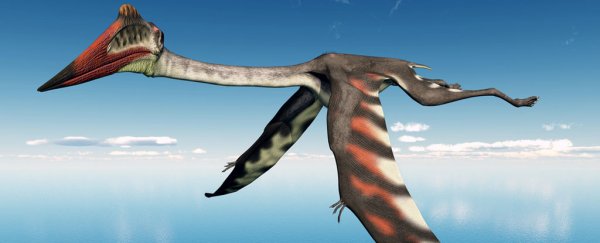The remains of an ancient flying predator that ruled the skies some 70 million years ago have been discovered in Mongolia, and researchers say the species likely ranked among the largest of its kind.
The fossil discovered belongs to a kind of pterosaur – a group of flying reptiles that lived around the same time as dinosaurs. These animals were the first vertebrates known to evolve the power of flight, and are thought to be the largest flying animals ever seen on Earth.
The pterosaur species unearthed in Mongolia has not yet been identified, but based on the size of the fragments of cervical vertebrae (neck bones) found, this sucker was huge.
"I immediately recognised that it might be a pterosaur and was astonished at its gigantic size," palaeontologist Takanobu Tsuihiji from the University of Tokyo told John Pickrell at National Geographic.
"Straight away, we went back to the site and discovered the rest of the specimen."
That site was a geological formation in the Gobi Desert called the Nemegt Formation, which has turned up numerous dinosaur finds dating back to around 70 million years ago.
But up until now, this fertile fossil patch has never produced a pterosaur – and the researchers say their find is indicative of just how widely distributed these ancient aerial predators once were during the late Cretaceous period.
While it's hard to estimate the size of an extinct pterosaur solely from chunks of neck, the team thinks its footprint would have been comparable to the two largest species we know about: Quetzalcoatlus and Hatzegopteryx, which had wingspans up to approximately 11 metres (36 feet).
That puts them, and potentially our Mongolian John Doe, on a par with a small plane – which, frankly, would have been terrifying if you were a small vertebrate being stalked and swooped by these things 70 million years ago.
"It's a really big vertebra, and the only thing comparable is some material from Romania," British palaeontologist and pterosaur expert Mark Witton from the University of Portsmouth, who wasn't involved with the discovery, told National Geographic.
"This is definitely up there with the largest pterosaurs, and there's nothing like it from Asia so far."
It's possible, Witton thinks, given the scarcity of bones so far found, that this animal might have been smaller than its peers, and that the neck bones found were disproportionately larger in this species for some unknown evolutionary reason.
Solving that mystery will require more fossils to be found, which could also help clear up just what these aerial giants once preyed upon.
For his part, Witton suspects they weren't too discriminating.
"They seem to be feeding on things on the ground," he said, "and are generalist in their ability to grab basically whatever they can fit in their beaks."
The findings are reported in the Journal of Vertebrate Paleontology.
